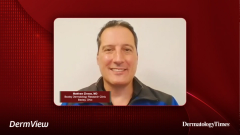
Safety and Efficacy of JAK Inhibitors
Key opinion leaders explain the box warnings and safety profiles of JAK inhibitors.
Episodes in this series

Linda Stein Gold, MD: Let’s start out by taking a look at why the FDA [Food and Drug Administration] has really broadened the safety information included in the package inserts and included some broader language for the box warnings. This goes back to a safety study where tofacitinib [Xeljanz] was studied in some post-marketing studies, as compared to 2 TNF [tumor necrosis factor] inhibitors. The questions was: Is tofacitinib noninferior in terms of the safety of the TNF inhibitors, in terms of major adverse cardiac events, and malignancies? The primary efficacy was safety of the 2 doses of tofacitinib: the 5 mg dose twice a day and the 10 mg dose twice a day. The bottom line, from this study, was that tofacitinib wasn’t found to be comparable. In fact, it was found to have an increased safety warning for both of these areas, and from this, the FDA has broadened the box warning for not just tofacitinib, but all of the oral JAK [Janus kinase] inhibitors. This language has also made it to the topical JAK inhibitor, ruxolitinib [Jakafi]. Let’s talk a little bit about these box warnings. There are several that occur with the oral agents, as well as with the topical agent, so there’s a box warning talking about the risk of serious infections, mortality, malignancy, major adverse cardiac events, and thrombosis. We’ll go into this a little bit more, but we’ll see that this is interesting because the study was only with tofacitinib, yet the box goes to the other oral JAK inhibitors as well as the topical JAK inhibitor. Matt, can you talk a little bit about how we now have both oral, as well as topical JAKs, and what’s the difference between using a JAK inhibitor topically as opposed to orally?
Matthew Zirwas, MD: Well, it really goes to the reason that we use anything topically rather than orally. There’s much less systemic absorption whenever we use topical JAK inhibitors. The best number I’ve been able to find is from a pretty good study that said about 6% of topically applied tofacitinib will get absorbed systemically, which is a small number, but you also have to remember that whenever you’re talking about a 1.5% topical, there’s 15 mg in every gram of medication. Whenever you look at this, the key takeaway is that 94% of the topically applied ruxolitinib does not absorb into your system, and that’s crucial because it leads to a lower exposure to the drug systemically. Whenever they did a maximum use study— this was in people applying ruxolitinib to over, I think, 25% of their body surface area—the average systemic exposure was still way below the oral dosing that it was compared to, and whenever they looked at patients that were less than 20% body surface area, the plasma concentrations were, as you would have expected, about 90% lower than with oral exposure. That’s really important because we know that at least some of the side effects associated with systemic JAKs are dose related, so reducing the dose certainly should reduce the risk of immunosuppression. We don’t know as much about if it reduces the potential thrombotic risk, but the key thing is that there’s this really reduced systemic exposure whenever we use it topically.
Linda Stein Gold, MD: That’s great. Especially for cutaneous diseases, we know that using it topically, we get it right at the site of action and it’s great to be able to minimize the systemic exposure. You and I were both involved in clinical trials for ruxolitinib [Jakafi]. There were 2 phase 3 clinical trials that looked at patients who had mild to moderate atopic dermatitis. They had 3 to 20% body surface area and the drug worked quite well. Matt, can you comment a little bit about the safety and efficacy of what we saw in the clinical trials?
Matthew Zirwas, MD: Yes. So, in the trials, over 50% of people who received ruxolitinib 1.5% twice daily got to clear—or almost clear—which is a pretty impressive result. It was a treatment success, which means they got to clear or almost clear and had at least a 2-grade improvement. So, if they came into the trial as mild, in order to be a treatment success, they had to get to clear. If they came into the trial as a moderate, they had to get to clear or almost clear. Over 50% of people reached that end point, which is a pretty amazing thing. Whenever we look at average easy improvement, it was a little over 70% average improvement. Those efficacy numbers are a little hard to put into context because we don’t have a lot of phase 3 trials for topic, or atopic dermatitis, beyond this because there haven’t been new agents that have come out in the last 15 years, but the itch data kind of knocks your socks off. There is a significant number of patients who reported significant itch relief on day 1, the day they put it on. Whenever we look at people who had at least a 4-point reduction in their itch numerical rating scale, by day 3. So that means if you started putting on ruxolitinib on Monday, the statistically significant reduction in itch, by at least 4 points, happened by Wednesday. It’s really surprising, to put it as mildly as I can, how rapidly this drug works for itch. I have never seen anything else like it.
Linda Stein Gold, MD: Yes, it is a really interesting drug, and I’ll have you talk a little bit about the mechanism of action in a few minutes. When we have a nonsteroidal drug, the topical JAK inhibitor is not a steroid, so that means that this is a drug that can be used on the face: potentially on the eyelids, on the skin folds, and on the hands. It really simplifies that regimen down to, what I like to say, “one stop shopping.” People always ask how this new drug compares to a topical steroid, and we know that in the phase 2 studies, they actually did have an active steroid control. They used triamcinolone cream, and we know that we did see a difference in the active drug compared with the triamcinolone. This was true by week 4 and later. So we can say it’s at least as good, or better, than a topical steroid. Do you agree with that Matt?
Matthew Zirwas, MD: I could not agree more. In my clinical experience, I’ve now treated probably 30 people with topical ruxolitinib since it came on the market. I actually think that it’s similar to clobetasol, an ultra-high potency topical steroid, in terms of efficacy, but it’s faster. If you think about what that means for facial atopic dermatitis, that you now can use the equivalent of clobetasol on atopic dermatitis of the eyelids or the face, the therapeutic leap forward here isn’t like anything I’ve ever seen in the topical world of my career.
Linda Stein Gold, MD: Really interesting.
Transcript edited for clarity.
Newsletter
Like what you’re reading? Subscribe to Dermatology Times for weekly updates on therapies, innovations, and real-world practice tips.




















